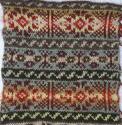Fair Isle
Fair Isle knitting originates from a tiny island that lies halfway between Scotland and Norway named Fair Isle. This type of knitting is distinguished by intricate patterns knit in various colors. Traditional Fair Isle patterns are limited to a palatte of about five colors, using only two colors per row and garments are worked in the round. The colors in traditional Fair Isle garments are very unique as the dyes were made from local lichens, leaves, and grasses, providing bright and distinctive colors. These were mixed with the muted wools derived from local Shetland sheep.
 Fair Isle can attribute much of it's popularity to the Prince of Wales (Edward VIII) who often wore sweater vests in Fair Isle patterns. The fashion soon became all the rage. After World War II ended many soldiers brought home Fair Isle garments, helping to spread the popularity of this distinctive knitting style. As the popularity of this distinctive style grew, knitters turned away from the traditional styles and focused on modern patterns in an effort to continue the growth of this new cottage industry. These days Fair Isle refers more to a two stranded method of knitting than it does to a distinctive area tradition.
Fair Isle can attribute much of it's popularity to the Prince of Wales (Edward VIII) who often wore sweater vests in Fair Isle patterns. The fashion soon became all the rage. After World War II ended many soldiers brought home Fair Isle garments, helping to spread the popularity of this distinctive knitting style. As the popularity of this distinctive style grew, knitters turned away from the traditional styles and focused on modern patterns in an effort to continue the growth of this new cottage industry. These days Fair Isle refers more to a two stranded method of knitting than it does to a distinctive area tradition.




